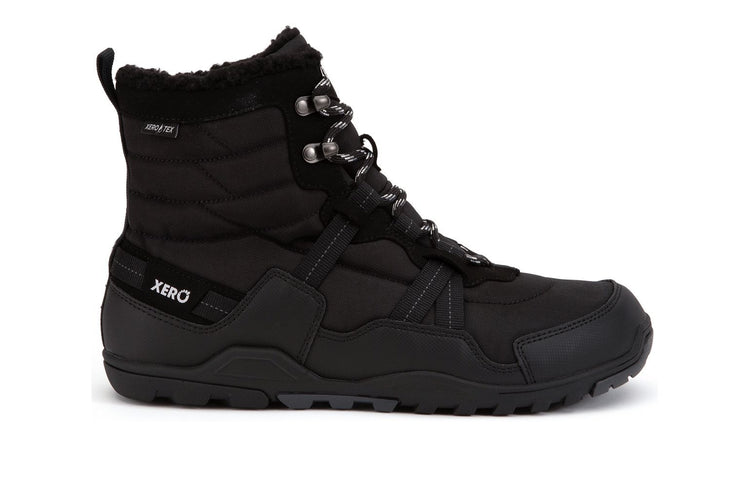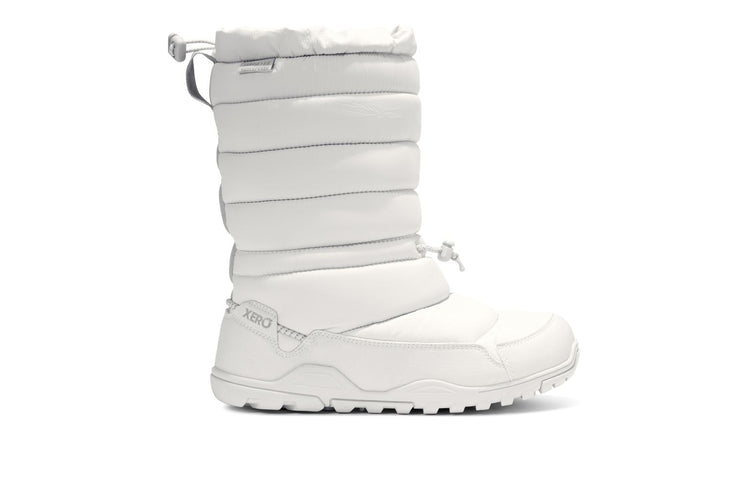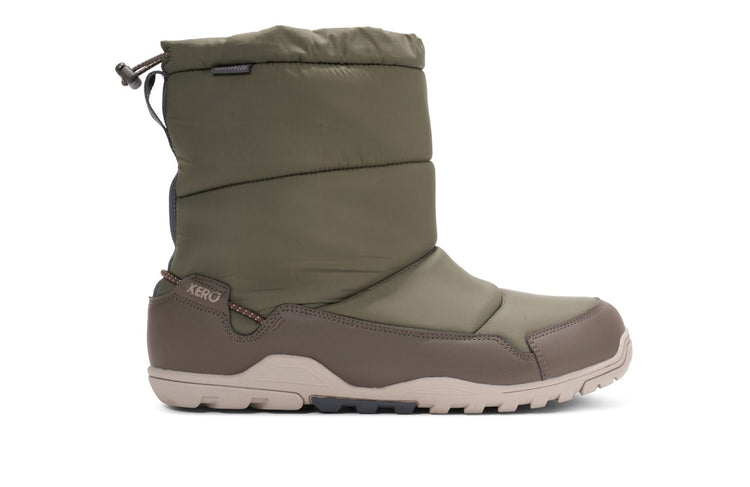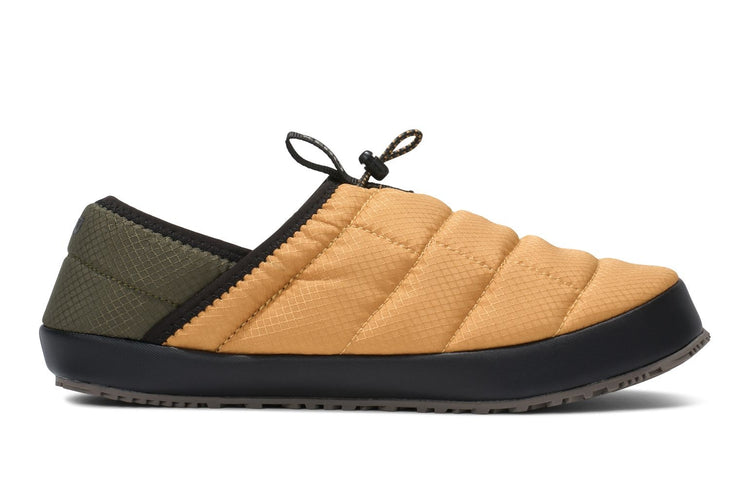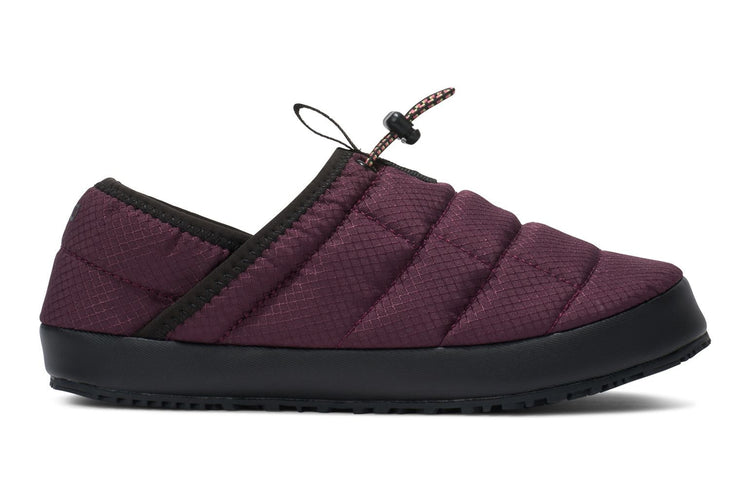latest News
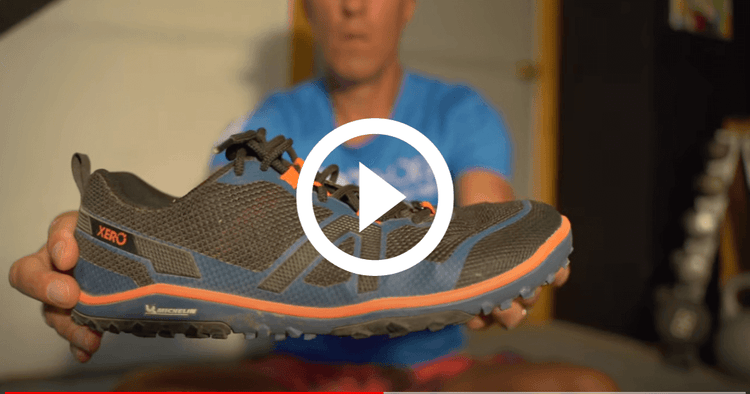
Running Coach and Author Eric Orton's Review of Scrambler Low
"The Scrambler Low performs exceptionally well on varying terrain, allowing me to go longer and stronger in a natural shoe." -Coach Eric Orton DISCOVER THE SCRAMBLER LOW
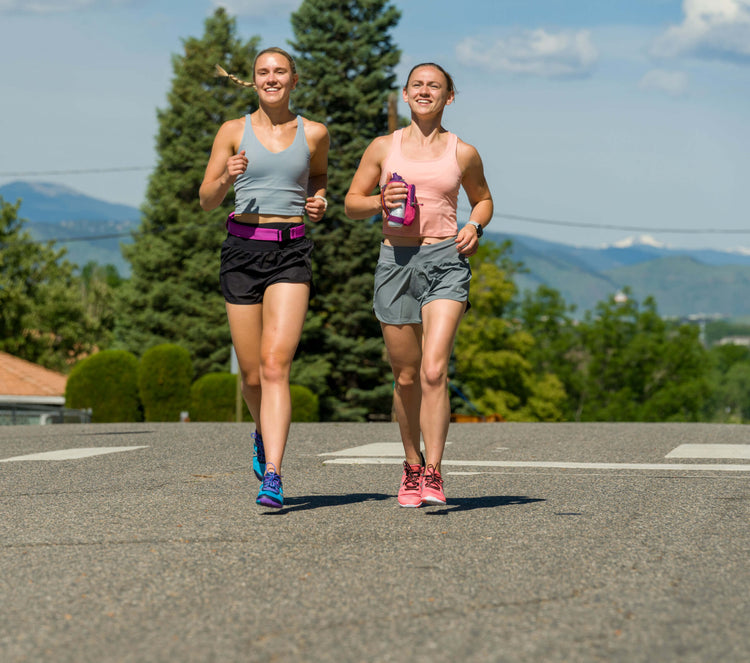
Organizations That Use Running to Empower Women
For women, running can be a powerful tool for empowerment and self-discovery. Running teaches women many physical, mental, and even social skills, when running in a group. It helps build confidence, reduce stress, and promote a sense of accomplishment and independence. Women of all ages join running groups that can help strengthen community bonds and offer a supportive environment for self-growth. Running delivers lessons on confidence and character and provides strength in the face of adversity. Running is one of the most accessible activities in the world - all you need is a good pair of running shoes and proper clothing. This article will show you how running can empower you, introduce organizations that recognize the power of running, and use running to make a difference in women’s lives around the world. Whether you're an experienced runner or just starting out, let's celebrate the power of running to transform lives and communities. What Factors Are Important For Women's Empowerment? Empowerment is the process of becoming stronger and more confident, especially in controlling one's life and claiming rights. The European Institute for Gender Equality defines women's empowerment as "the process by which women gain power and control over their own lives and acquire the ability to make strategic choices". Several factors contribute to women's empowerment. Some of the most important include: Access to Education Women who have access to education are better equipped to make informed decisions about their lives. This helps them participate in the workforce, and advocate for themselves and their families. Economic Empowerment Women with financial independence are more likely to have control over their lives and make decisions about their futures. This can be achieved through equal pay, access to credit and loans, and job training programs. Healthcare Access to quality healthcare is critical for women's well-being and ability to lead healthy and productive lives. This includes access to reproductive and maternal health services. Gender Equality Women face gender bias in education, employment, politics, and more. Achieving gender equality requires breaking down systemic barriers and addressing gender-based discrimination. Safety Women need to feel safe in their homes and communities in order to fully participate in society. This includes addressing issues such as domestic violence, sexual assault, and harassment. Representation Having women represented in leadership roles is crucial for ensuring that their needs are met. Empowering women to be part of decision-making processes, instead of others speaking for them, will help their voices be heard. Benefits of Running for Women Regular running can provide a wide range of mental and physical benefits for women to improve all aspects of their well-being. Physical Health Many people consider running simply a way to burn calories and lose weight. However, there are many other physical benefits besides weight loss. As a cardiovascular exercise, running improves heart health while reducing blood pressure and the risk of chronic diseases. Builds Confidence Completing a challenging run or race can build confidence, giving women a sense of accomplishment and achievement. Running can also boost women's self-confidence to feel more comfortable and confident in their bodies. Reduces Stress Running can relieve stress, providing an outlet for pent-up emotions. Running also can reduce stress by promoting the release of endorphins, which improve mood. Improves Mental Well-being Running can be a form of meditation and can have long-term benefits for mental health. Running a few times a week gives women a space to clear their minds and focus on the present moment. Accomplish Goals Women face different challenges in life than men. To overcome challenges, it’s important for women to set goals and experience the satisfaction of achieving them. The same is true for running performance, which requires runners to overcome physical and mental obstacles. By setting goals, runners can create a clear action plan towards accomplishing those objectives and ultimately experience the sense of achievement that comes with meeting those goals. Learn Resilience Not every run will be your best, especially if you're new to running. Setbacks may happen, but this is a great way to learn resilience. Getting better at something means getting back up after you’ve been put down and trying again. Running teaches women ways to overcome stress and bounce back from adversity - a great skill to help anyone overcome life’s challenges. Build Bonds and Community Women’s running clubs and track and field teams provide a sense of community, empowering female athletes. Being a part of the wider running community offers women a supportive social group and role models to look up to. Empower Other Women Running is a great solo activity, but most runners know the importance of having a good running community. In group settings, running helps women empower each other. Women’s running groups are the perfect instance to build other women up. Organizations That Are Helping Females Achieve Empowerment Through Running Here are some organizations that are empowering women around the world. Jay Ell Alexander, Black Girls RUN! Jay Ell Alexander is the owner and CEO of Black Girls RUN!, an organization that empowers women of color through running in a supportive environment, with over 250,000 members across the United States. She is a public relations practitioner committed to giving back to the local community through her passion for running, health, and fitness. What is the goal of Black Girls RUN? “Black Girls RUN! started as an online blog in 2009 as a way to empower Black women to participate in the sport of running events across the country and provide spaces for women to come together on their fitness journey. Through the power of running, community and empowerment, we bring awareness to the health disparities in the Black community. We dispel the myths that black women are unhealthy and not physically active.” How does running help empower black women to overcome challenges they may face? “There’s a huge misconception that black women don’t run. Black Girls RUN! brings women together all over the country to increase representation on the pavement. We are moving and motivating women to change the narrative of what running and health looks like for black women. We provide inspiration and serve as a resource for women to become the best version of themselves. Black Girls RUN! aims to create healthier communities to change the health statistics for black women and create healthier women for generations to come.” Girls on the Run Rockies Girls on the Run Rockies inspires girls of all abilities to reach their full potential through running and team support. They teach life skills such as self-confidence, resilience, and connection with peers. Dedicated volunteer coaches combine physical activity with these lessons to empower girls and create a strong community. We interviewed Lauren Pietrek, Development and Marketing Director for Girls on the Run Rockies. What is the goal of Girls on the Run? “Girls on the Run is a nonprofit organization with a mission to inspire and empower girls in 3rd - 8th grade through the power of running. Our program combines training for a 5K event with a research-based curriculum that focuses on developing essential life skills and fostering positive self-esteem. The goal of Girls on the Run is to equip girls with the tools they need to navigate challenges, build healthy relationships, and boldly pursue their dreams. We create a supportive community where girls can embrace their uniqueness, celebrate their strengths, and grow into strong, capable women.” What role does running play for girls to overcome challenges and learn new life skills as they grow older? “Girls on the Run uses running as a tool to build confidence and teach life skills by setting and achieving running goals, fostering a growth mindset, and employing a curriculum that addresses topics like self-care, empathy, and teamwork. Through running, girls develop resilience, self-belief, and a sense of accomplishment. Our program creates a supportive environment for girls to learn and practice important life skills while running with their friends. We believe the finish line of our 5K is just the beginning of a lifetime of self-confidence.” Whitney Heins, founder of The Mother Runners Whitney Heins is a lifelong runner, and founder of The Mother Runners, (a resource for moms who run), VDOT-O2 certified running coach, 2:54 marathoner, host of The Passionate Runner podcast, and most importantly, a mom of two beautiful, crazy kids. What is the goal of The Mother Runners? “My mission is to help fellow moms be their best selves on and off the road. When we do something that makes us feel good about ourselves, that positive impact has a ripple effect in all we do. Running is good for our physical and mental well-being and teaches our kids valuable lessons like how to take care of yourself and work hard towards your goals.” How does running empower mothers to overcome challenges they may face in their daily lives? “Running helps moms see that they are stronger than they realize. This ability to have patience and persevere no matter what carries over into challenges moms face big and small—whether it’s withstanding another toddler meltdown or facing serious illness or tragedy related to our children. It also recharges us so we can face each day fresh.” In addition to free training plans and customized coaching, she provides a community for sharing experiences and pursuing fitness goals. Keri Wallace, Girls on Hills Keri Wallace is the co-founder of Girls on Hills, an organization that empowers women with the skills and confidence to become independent in the mountain environment. Girls on Hills provides guided runs in the Scottish Highlands, Lake District and Snowdonia and are aimed at women who want to break free from road running and run to the mountains. What is the goal of Girls on Hills? Girls on Hills aims to empower women with the skills and confidence they need to become more independent in the mountain environment. We hope to encourage more women to participate in the sport of trail and mountain running to reap the health and well-being benefits associated with exercising in wild spaces and time spent in nature. We use experienced female running guides to teach navigation, movement and mountain safety skills on upland terrain, from trail to technical mountain ridges. We believe that 'empowered women empower women' and our guides are instrumental in helping us inspire women to try new things. We also advocate for greater understanding of inequities and better support for women to help reduce the gender gap in participation in ultra-distance running and skyrunning in the UK. In Your Opinion, how does trail running empower women to overcome challenges in their daily lives? Trail running is liberating! - journeying through nature with all you need on your back, making decisions about your route, destination and safety. This kind of control can often be lacking in people's lives, and today's health and safety culture breeds a level of risk aversion that is limiting and sometimes debilitating. At Girls on Hills, trail running is about understanding and stretching what your body (and mind) can do! Often women find they are far more capable than they expected. Another kind of empowerment is learning new skills, such as self-navigating or moving efficiently over technical terrain. We find that running in a supportive and like-minded group can help build community and self-esteem, but running solo can build resilience and self-confidence. All these elements of empowerment are powerful and extend beyond running into lives at work and at home. Inspirational Female Runners Who Changed History Here are some iconic women runners whose effect empowered others and changed history for generations of women after them. Their confidence and resiliency paved the way for future female runners. Wilma Rudolph Wilma Rudolph overcame polio and scarlet fever as a child to become one of the fastest women in history. As a young girl who struggled to walk, she truly defied the odds as the first woman (and first African American woman) to win three gold medals in track and field at the same Olympic game. At the 1960 Summer Olympics, Rudolph won gold in the 100- and 200-meter sprint events and the 4 x100-meter relay. Her incredible life story has inspired generations of women long-distance runners. Kathrine Switzer Before the Boston Marathon allowed female participants, 20-year-old Kathrine Switzer showed up to the race in 1967. She signed her entry form under the alias "K.V. Switzer" as the first woman to win a competition. Despite being physically pulled off the course by multiple men, including the race's director, Kathrine became the first woman to enter and finish the marathon with an official race number. Switzer is credited for changing the sport of running by opening up opportunities for female long-distance runners. Today, she continues to pave the way for other female runners, inspiring women across the globe and winning the New York City Marathon in 1974 with a time of 3:07:29. Joan Benoit Samuelson Joan Benoit Samuelson is an iconic American runner and olympic gold medalist. She won a gold medal as the first-ever women's marathon champion at the 1984 Olympic games - just 17 days before she had knee surgery, calling into question whether she would participate in the event. On race day, she was able to push from within, taking the lead at Mile 3 and never giving it back. Her stunning effort is commended and inspired by long-distance runners. Joan also held the fastest time for an American woman at the Chicago Marathon for 32 years after winning the race in 1985. All You Need Is a Good Pair of Shoes The good news is, you don’t need much equipment to run - just a pair of running shoes on your feet. Your running journey begins by finding a pair of shoes that are both durable and comfortable - shoes you can wear for (literally) thousands of miles! Barefoot running shoes prioritize natural movement and allow your feet to move and flex as they were designed to, while still offering a layer of protection. A barefoot feeling allows your feet to get the ground feedback you need to become a confident, empowered runner. Barefoot shoes have important characteristics that let your body do what’s natural, and let your feet bend, flex, move, and FEEL. Compared to traditional running shoes, Xero shoes have: No heel lift A wide toe box to let your toes spread No unnecessary cushioning An extremely flexible sole that gives you protection but is thin enough to let the nerves in your feet safely FEEL the ground and be more connected to the earth. When it comes to running shoes, durability and style should go hand in hand. That’s why we offer a range of options that not only look great but can handle any terrain you will be running on. Women’s road running shoes: Prio HFS Zelen Women’s trail running shoes: Mesa Trail II TerraFlex All of our shoe models are backed by a 5,000-mile sole warranty. Explore our entire collection of barefoot shoes for women. In Closing Running is used as a tool for empowerment and self-discovery for women across the globe. It is an activity that pushes you to become resilient, confidence dedicated, and motivated. Through the work of these incredible nonprofits, women are being empowered and supported to reach their full potential through running. It is up to all of us to continue this work and support women's empowerment in our communities and beyond. There are many women’s running groups that you can find locally to join that welcome all abilities. You get experienced coaches and build a sense of community through running. Whether you run in a group or solo, we hope women use running as an activity of empowerment to be the best versions of themselves.
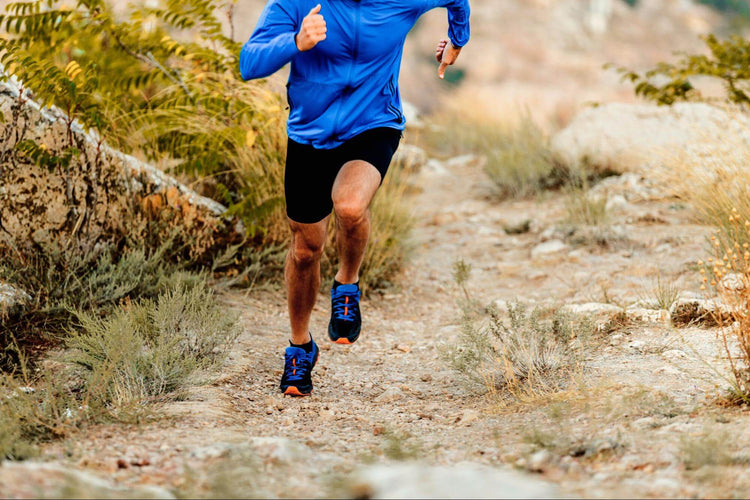
How Runners Can Support the Environment for Earth Day
Runners who want to help preserve and protect the environment can take several steps to become more eco-friendly. Here are some inspiring ideas runners can do to help support the environment.Does Running Help The Environment?Running has some unique features that already make it a sustainable activity, including:Carbon-NeutralityRunning is a carbon-neutral activity that doesn't require any fuel or energy other than your own. Choosing to run means that you can reduce your carbon emissions and help create a cleaner environment.Encourages Sustainable FitnessRunning is a minimalist activity that requires little equipment or resources. By embracing minimalism, runners can contribute to a more sustainable lifestyle and promote the idea of living within our means.Inspires Community InvolvementRunning events and clubs can bring together individuals with a passion for health and fitness as well as sustainability. These communities can inspire collective action and advocacy for environmental issues.Promotes Green SpacesRunning can take you to places where you can appreciate the beauty of nature. By doing so, you are helping to promote the importance of parks and green spaces, natural resources, and the need for their preservation.Supports Eco-Friendly EventsMany running events have embraced eco-friendly practices, such as recycling, composting, and reducing waste. By participating in these events, runners can support these initiatives and encourage others to adopt similar practices in their daily lives.How To Help The Environment As A Runner (10 Ways)1. Throw Away Your TrashThrowing away their trash is a pretty easy way runners can support the environment. Beyond trail hiking, litter is often left behind by road running in cities. Just because it's widely accepted to leave trash on the ground doesn't mean you should. Try these tips: Always carry a small reusable bag or pouch to store your trash during your run. If you find trash while running, pick it up and dispose of it, or recycle it if possible. Avoid single-use plastic to reduce the amount of plastic that ends up in landfills. Support products that are made from 100% recycled materials. Educate your fellow runners and friends about the importance of properly disposing of trash and encourage them to follow suit. 2. Reduce Plastic Waste From Water BottlesInstead of using water bottles during or after your run, consider switching over to a 100% plastic-free water bottle. There are several non-plastic water bottles for runners. Many of these manufacturers not only use sustainable practices, but they also give charitable donations to support sustainability non-profit organizations.Organization Spotlight: Plastic Free JulyPlastic Free July® is a significant program developed by the Plastic Free Foundation. Its purpose is to help us move closer to our goal of creating a world free of plastic waste.3. Participate in Park Clean-upsA great way to give back to your community is to find a park clean-up in your neighborhood. You could even organize your own. Local volunteers of all ages can work together to clean and pick up litter in a community park. Volunteering is a great way to keep the parks and green spaces you run in clean and beautiful. 4. Find Plogging GroupsAnother way to dispose of trash is by participating in plogging, but what is it exactly?? It is an activity that combines jogging and cleaning up trash. While running, they collect and properly dispose of any litter found on the ground. The term “plogging” originates from the Swedish verbs “plocka upp” (pick up) and “jogga” (jog).Organization Spotlight: Natural RestorationsNatural Restorations is an Arizona-based 501c3 nonprofit organization founded in 2015 by husband and wife team, Justin & Nicole Corey. Their mission is to remove trash and graffiti from outdoor recreation & wilderness areas, revitalize natural areas through replanting projects, and enrich the lives of military veterans and other community members. They have removed over 1.5 million pounds of trash from outdoor spaces and will be hosting their 8th annual Earth Day Lower Salt River Cleanup this Saturday, April 22nd. Plogging combines picking up trash while jogging and it is a great way for runners to make a positive impact on the environment and in our communities. With increased concerns about pollution, people everywhere are making their workouts good for the Earth's health too! Instead of cursing trash as you jog by it, why not pick it up? It's like a treasure hunt every time you head out. The action of picking up trash stretches the back, hamstrings, and calves. It's multitasking at its best!DonateFacebookInstagram 5. Donate Old Running GearDonating old gear is an excellent way to reduce environmental impact. It allows runners less fortunate to have safe footwear they may not be able to afford. Donating old clothing helps reduce waste in landfills and decreases the emission of methane into the air.Organization Spotlight: Soles 4 SoulsSoles 4 Souls turns old or unwanted shoes and clothing into good use, preventing them from going to waste. providing relief, creating jobs, and empowering people to break the cycle of poverty. Collect shoes and clothing to distribute to people in need across the US and worldwide. This protects the planet, putting used goods to others who need them instead of going to a landfill.Donate ShoesFacebookInstagram 6. Advocate for Environmental PoliciesAdvocating for environmental policies can be a powerful way for runners to make a positive impact on the planet. Advocacy can take various forms. One of them is reaching out to local and national representatives, joining protests or rallies, and backing environmental organizations.One way to get started is by researching environmental policies that are currently being proposed or debated in your area. This might include initiatives related to renewable energy, reducing your carbon footprint, protecting natural resources, or promoting sustainable transportation options.Once you have identified relevant policies or initiatives, consider reaching out to your elected representatives to express your support or concerns. This could involve: Writing letters or emails Making phone calls Scheduling in-person meetings with your representatives or their staff Organization Spotlight: Runners for Public LandsRunners for Public Lands is on a mission to create a sense of belonging, a connection to the environment, and to spark activism in our running communities.When college professor Vic Thasiah read the notable article “No Free Lunch: Trail Running and the Public-Lands Debate” by Mike Foote in Trail Running Magazine, he decided to take action. On Earth Day in 2019, he founded Runners for Public Lands as the national-level nonprofit dedicated to organizing runners - the largest recreation group in the US - to care for the environment. Today, Runners for Public Lands continues to build inclusive running communities dedicated to protecting the environment and is actively creating opportunities for runners to get involved and give back.Founded in Ventura, CA, RPL has established a strong regional presence, but earlier this month, they officially launched their Ambassador Program in Colorado to begin growing a movement of runners throughout the country. RPL Ambassadors will host inclusive runs, organize educational and volunteer events, and activate runners to steward and protect the lands they run with. Keep an eye out for more to come as this movement grows into new communities throughout the US!So, how can you join this movement to protect public lands and equitable access to nature? Volunteer for trail days and local stewardship in your community. Get informed about ways to protect the people and places you love to run with by: downloading RPL’s toolkits, reading RPL’s event resources, and learning about RPL’s Everyone Runs Funds - a grant that assists disadvantaged runners chasing their run dreams. Follow RPL on social media @runners4publiclands and sign up for their newsletter. Become a sustaining member of Runners for Public Lands. Make a one-time donation to support RPL programs and expand their presence in the US. Stayed tuned for specific RPL calls to action on national-level policies impacting runners and protecting public lands. Donate hereFacebookInstagram 7. Run or Walk to PlacesRunning is a great alternative mode of transportation to reduce carbon dioxide emissions from cars. Fewer miles driven can have a big impact on greenhouse gas emissions. Running and walking are the most energy-efficient options. However, if your destination is too far, consider riding a bike or using public transportation when possible. 8. Attend Sustainable Road RacesMany road races are getting serious about being environmentally friendly. Road races can get littered with trash, including cups. Instead, some races opt for reusable, compostable, or biodegradable cups at water stations. Road races are also moving paperless registration.9. Run for SustainabilityRoad races are not always set up with sustainability in mind. However, there are many races you can take part in that prioritize sustainability. Some park organizations will raise money with a 5k or 10k race. Of course, you can also raise money for an environmental charity.10. Wear Sustainable Running ShoesWear shoes made from sustainable materials that are ethically sourced and built to last a long time. Most “sustainable shoes” are not completely sustainable, even if they claim to have an ethical code of conduct. Greenwashing is a marketing tactic used by companies to make their products appear more environmentally friendly than they actually are. It involves making false or misleading claims about the environmental benefits of a product, service, or effects of the supply chain.At Xero Shoes, we’re sensitive to the ecological impact of footwear manufacturing. We are truthful about our environmental impact and share our green story only when it's authentic. We do not participate in the deceptive practice of greenwashing. Becoming a More Sustainable RunnerBecoming a more sustainable runner is a powerful way to contribute to the health of our planet. You can help create a more sustainable future by making small, simple changes. Whether you're a seasoned runner or just starting out, think about how you can make your running routine more eco-friendly. By working together, we can create a better planet for ourselves and future generations.

Yes, You Can Wear Barefoot Shoes with Flat Feet or High Arches. Here’s Why
Not infrequently, when someone takes a look at my barefoot shoes, they will say: “I wish I could wear barefoot shoes, but I can’t do that. I need support.” “Oh?” I’ll respond. “Why do you need support?” Then something happens that I love. I get one of two seemingly contradictory answers. Either: “I have flat feet!” “I have high arches!” They usually add to their proclamation some form of external validation, like, “I’ve seen one of the best podiatrists in the world and he agrees that I need orthotics.” Oh? Your podiatrist agrees that you need to give him or her an additional $300-1,000? What a shock. Contrary to what many people believe, high arches and flat feet are not necessarily a problem. To understand why not, you first need to know a little bit about arches and what can go wrong with them. Then we’ll talk about what the problem really is and why there is usually a better solution than orthotics. Finally, even if you are going to wear orthotics, barefoot-inspired shoes are a great choice. Keep reading to find out why. A Quick Look at the Anatomy of Your Feet Why do our feet have arches, anyway? If you look carefully at an average foot, you’ll actually see it has 3 arch shapes in both directions – from front to back and side to side. When people talk about high or low arches, they're referring to the medial longitudinal arch. It’s the one that runs lengthwise on the inside of each foot. This flexible arch does two important things. When allowed to function naturally, it can easily handle the impact forces generated each time your foot lands on the ground. Second, it acts as a spring, which helps to absorb energy on impact and return some of it when you lift your foot again. Why Do Flat Feet or High Arches Matter? Frankly, they don’t for the vast majority of people. In fact, a study found that arch height made no difference in pain or function of the foot. Many people who have a low or high arch will never really notice it. Obviously, if something is wrong with your arches, there is the potential that they won’t adequately perform those two functions of handling impact and providing spring-like rebound. For a very small number of people, very low or high arches can interfere with the function of the foot. If you’re in this group, you’re probably already well aware of it. For most people, again, arches that are higher or lower than average aren’t a problem. We all fall along a continuum of arch height and the shape of our particular feet is mostly a matter of genetics. The Real Problem and What to Do About It But maybe you have noticed something about your arches – high or low – and wondered if there is anything you should do. Most people have heard that they need some support, ranging from specially-designed running shoes to custom-made orthotics. All of these options are expensive; do they provide any benefit? The evidence suggests they do not. One study, for instance, looked at groups of children with flat feet for a few weeks and found that adding orthotics made no statistically significant difference. Here’s the really interesting part. We do have research that flat feet can be improved by exercising the muscles of the foot. (The linked study, by the way, also found that orthotics didn’t help.) To me, this makes perfect sense. Our feet are a complex combination of muscles, tendons, bones, and ligaments. Strengthening the muscles helps everything to function the way it should. I’m not a scientist or a podiatrist. But when I look at the research, it seems like the problem for many cases of flat feet isn’t that the foot needs support. That is, the “cure” for the problem is not putting your foot in a cast (which is essentially what an orthotic is), It's making it stronger by using it in the same way that your bicep gets stronger when you do bicep curls. Science writer Gina Kolata reports the conclusion reached by Dr. Benno M. Nigg, a scientist who studies orthotics: “The idea that [orthotics] are supposed to correct mechanical-alignment problems does not hold up.” Are Barefoot Shoes Good for Flat Feet? Yes, barefoot shoes are good for people with flat feet, allowing feet to move more naturally and strengthen muscles in your feet for improved support. This is good news for those interested in barefoot-inspired (or “minimalist”) shoes, or even trying barefoot running. Why? One benefit of walking or running naturally, the way our ancestors did, with a bit of protection (like you get from barefoot shoes), or even in bare feet, is that you engage the muscles of your foot in a way you don’t in “traditional” shoes. That’s because “normal” shoes have thick soles with lots of support and cushioning that limits the movements of your feet. Stiff arch support inserts limit motion even further. What happens to muscles that don’t move? They get weaker, as a study of the effects of orthotics on foot muscles demonstrated. The idea that going barefoot or wearing barefoot shoes helps develop foot strength isn’t speculation. A study by Dr. Sarah Ridge in 2019 found that merely walking in minimalist shoes strengthens foot muscles as much as doing a foot strengthening exercise program. (By the way, Dr. Ridge says you should get the same benefits wearing Xero Shoes as the shoes used in that study.) Another study confirmed muscle gains with minimalist shoes and also noted increased arch stiffness. In case some of these terms are new to you: barefoot or minimalist shoes are designed to let your feet move as naturally as possible. Unlike a “traditional” shoe, they have thin soles that are flexible and let you safely feel the ground. They also have “zero drop” — that is, they don’t slope downhill from heel to toe. Finally, a barefoot shoe will have a roomy, foot-shaped toe box to give your toes plenty of room to move. I need to say it again: I’m not giving you medical advice and you should consult with your doctor about any problems you’re experiencing with your arches, preferably one who understands the research and the value of natural movement. But I am encouraging you to at least consider the possibility that you can enjoy the freedom and fun of wearing barefoot shoes if you have flat feet — even if you’ve assumed you would always need “comfortable” and “supportive” traditional shoes. The Best Running Shoes for Orthotics? But let me just add one more thing. Suppose you are someone who uses orthotics and plans to continue to do so. I think you are still best off choosing barefoot shoes. Why? Look inside all the shoes you have now and note what you see. Each pair will have a different shape; some with more arch support, some with less; some with more slope from front to back, some with less, etc. Your orthotics are designed to fit your foot while resting upon a level base, but the inside of most shoes is anything but level. What this means is that every pair of shoes you wear will fit differently, and probably none of them provides a level platform on which your orthotics can rest. Moreover, as the foam midsole in those shoes breaks down (which it starts doing the moment you begin wearing them), the geometry of the shoe and orthotics will change which could cause structural problems in your feet and legs. Barefoot shoes have a flat, zero-drop sole that provides the perfect base for your orthotics and no foam midsole that wears out. So with or without orthotics, barefoot running shoes are a great choice. My own story Personally, I had flat feet my whole life. If I stepped out of a pool, my footprint looked like an oval. After a few months of running and walking barefoot, I noticed I started developing arches! I ruined all the family jokes about the flippers I had at the end of my legs. Now, I get out of the water, step on the ground, and you see the outline of a FOOT. Granted, I don’t have drive-a-bus-under-them arches but, again, that’s genes. All I know is that I haven’t used my expensive shoe inserts since 2009 and my feet haven’t had a problem in all that time. Ready to try your own pair of barefoot shoes? Take this quiz to find your perfect pair here. The content of this post does not constitute and is not intended to be a substitute for professional medical advice, diagnosis or treatment. Always seek the advice of a physician or other qualified health provider with any questions or concerns you may have about your health or a medical condition.
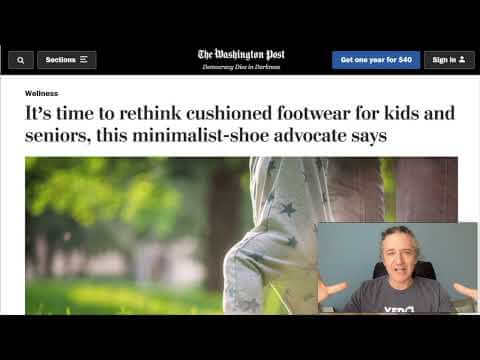
The (Fake?) Barefoot Shoe Debate - Washington Post
Here we have it yet again.Most articles about "barefoot shoes" start by reporting RESEARCH (I'll keep capitalizing that to make a point) and expert opinions on the pro-barefoot side, and bad arguments (at best) presented as the con-side, most of which don't actually have anything to do with the RESEARCH. In the rare times where the counter-argument refers to a study, diving more deeply into that study often reveals methodological problems.The article in question this time is in the Washington Post titled "It’s time to rethink cushioned footwear for kids and seniors, this minimalist-shoe advocate says"In this video, below I walk through the article and, hopefully, add some useful perspective and color. Oh, and this video is a preview of The MOVEMENT Movement podcast. Find more episodes here. What do you think? Leave a comment below.
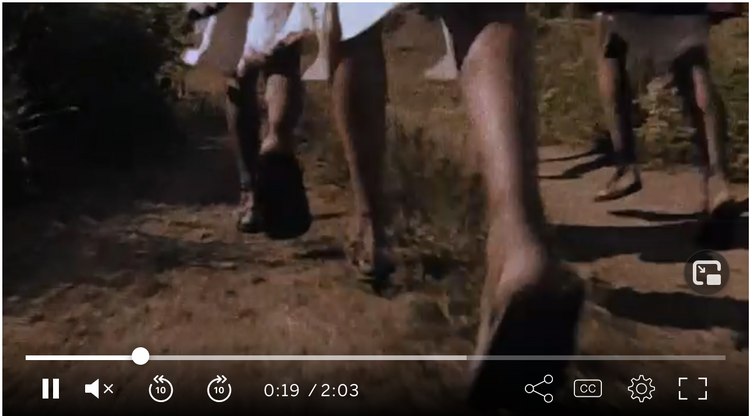
"The Infinite Race" - A meta-review about the 30-by-30 Documentary
The new 30-by-30 documentary, "The Infinite Race" about the Tarahumara premieres on December 15th.Outside magazine reviewed the movie and here's a review of the review... which is important to understand to, well, understand the movie.I'll be reviewing the movie, too, but this "meta-analysis" might put things into context for you.I'm not completely debunking the "debunking" that this review says the movie does... and, in fact, even the review doesn't do so, despite the claim of the headline.Find out more, I think you'll think it's interesting.One thing I didn't mention in my review: Why now? Born to Run came out 11+ years ago. The "barefoot boom" has, according to many, faded. So why is this important now?Not to suggest questions of cultural appropriation or that the unintended consequences of publicity might be worse than the benefits of that publicity. But the review suggest that the movie is attacking some "straw men" rather than addressing some of the bigger, more valuable questions.I'm looking forward to seeing the film to find out for myself and I hope you do the same.We were inspired by Born To Run and the Tarahumara and, happily, have donated a % of our revenue to support the Tarahumara through the Tarahumara Childrens Hospital Fund -- www.tchforegon.orgWhat do you think? Leave a comment, below.
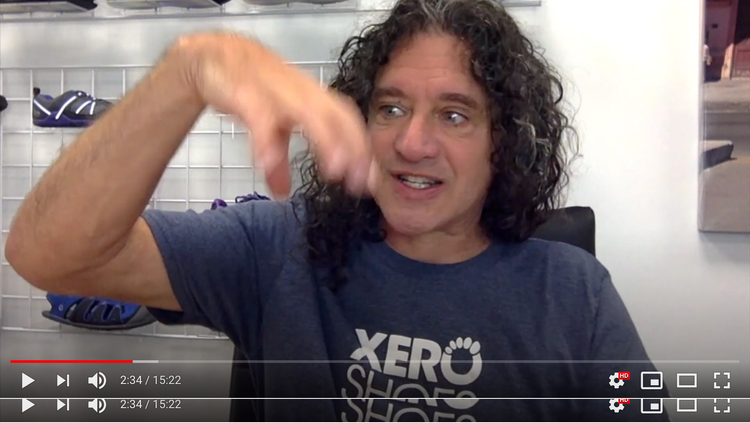
Do Running Shoes Make You Stupid?
This post is NOT what you think.But then again, it kinda is. ;-)Check out this video and let me know if you're a SMART runner.In short, there are two aspects to wearing running shoes from "Big Shoe" (note how that = "B.S.") which could not only affect your brain, but whether you're able to safely and enjoyably run, walk, hike, workout, or do pretty much anything else on your feet.One has to do with natural movement. The other has to do with your brain.Whether you wear traditional running shoes or minimalist or barefoot shoes, I think you'll get a kick out of this and I'd love to hear your comments, below.
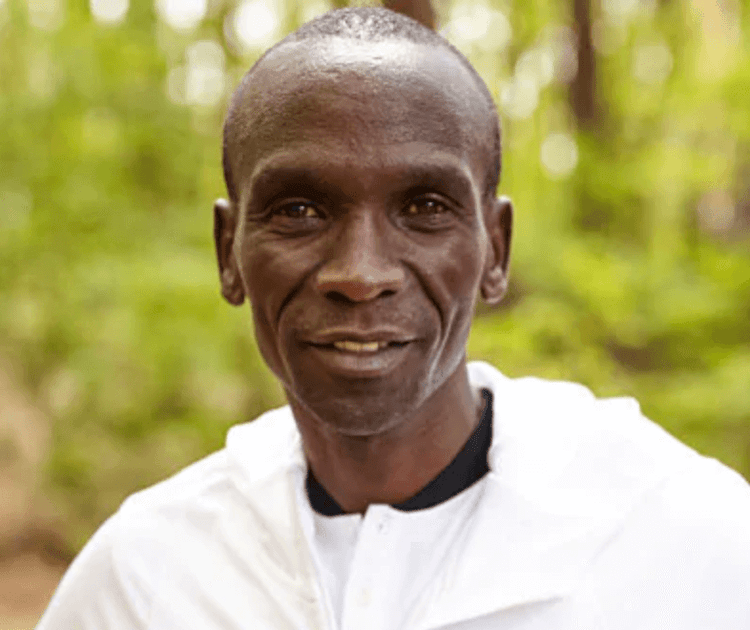
Eliud Kipchoge: It's NOT the shoes!
I'll admit it.I love being right.What am I right about this time?The importance -- or lack thereof -- of shoes in Eliud Kipchoge's sub-2-hour marathon performance.I've talked about how shoes were NOT the delimiting factor in Kipchoge's amazing run here, and in my podcast here, pointing out that the difference between his world record time of 2:01:38 in the Berlin marathon is only 4.58 seconds/mile slower than the sub-2, which was run with pacers, on a flat course (a.k.a. perfect conditions).Well, guess who agrees with me? KIPCHOGE!At Firstpost.com, sub-2-hour marathoner Eliud Kipchoge weighs in on how much of his success came from the Nike shoes he (and his pacers) wore for that event.The answer?Not as much as Nike or most commentators said.More specifically:“It is my legs that are still doing the running,” the Kenyan marathon runner told Firstpost in an email interaction when asked about the impact of his shoes in the eventual timing of 1:59:40 secs.Agreed.Running ~13 miles per hour for almost 2 hours is an AMAZING feat (pun intended).But the way his accomplishment has been reported is mostly about how the shoes allowed him to do this.And Kipchoge further downplays the role of shoes in his success:“Innovations are part of sport and always have been. With running, the effect of technology will always be minimal especially if you compare it to other sports.”Distance running coach, Dr. Phil Maffetone, thinks shoes DO matter, but not for the reason most people believe.In his book, "1:59 - The Sub-Two-Hour Marathon is Within Reach," Maffetone thinks the first person to run a sub-2 in a normal race will do so barefoot (I think his 2nd choice would be something like our Speed Force).Some day, I hope we have the resources to pick the world's best marathoner, support him (or her!) to train barefoot or in Xero Shoes, and show that lightweight (you can't get lighter than bare feet) and natural (hard to get more natural than Xero Shoes) will "let your legs do the running" to a sub-2.
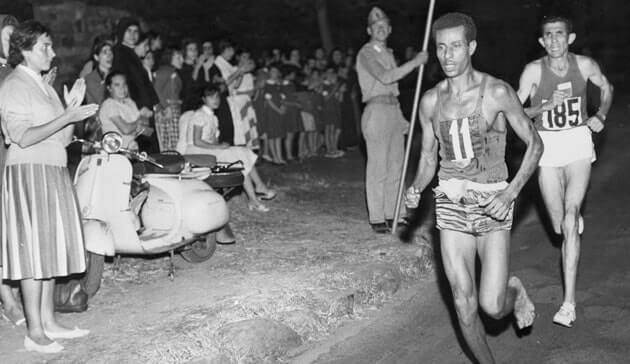
Abebe Bikila and his Barefoot Marathon Gold Medal
While the 2020 Tokyo Olympics are postponed until next year, now as great time to look back at one of the moments that helped shape the modern barefoot running movement.It was 60 years ago that Abebe Bikila won a gold medal in the Rome Olympics running in bare feet.A great article called OLYMPICS FLASHBACKS: THE SCIENCE OF BAREFOOT RUNNING AND WINNING GOLD shares the details, many of which people don't know.For one, Bikila didn't plan to run in bare feet.The shoes from his footwear sponsor gave him blisters so he decided not to wear them.The article also talks about how:In the past two decades, emerging research and Christopher McDougall's 2011 bestseller Born to Run kicked up a fiery debate about the merits of barefoot running. Some experts argue modern running shoes hamper humans' natural stride, while others say they are vital training tools to prevent injury and stabilize the foot.While there's no arguing that the debate is "fiery," when the barefoot vs. shoes conversation is presented, it's often done as if the two sides are evenly matched.They're not.There's no question that modern shoes affect people's stride. Research from Dr. Irene Davis at Harvard, and many others, repeatedly show this, and how shoes may even CAUSE the problems that they claim to cure or, at least, don't help the way most people expect after reading the promo material from the manufacturers.For example, when it comes to how well modern shoes "prevent injury," let's just look at Nike's new React Infinity Run.This shoe is marketed as "Designed to reduce injury" and "In an independent study, the shoe reduced injury rates by 50%."(I had a photo of their in-store marketing, but I can't find it :-( )Well, both are true... ish.Of course ALL modern performance shoes are designed to reduce injury. Nobody makes or sells a shoe that they know will cause MORE injuries.But the "independent" and "50%" are a bit of a red herring.The independent study was designed by and funded by Nike.The 50% injury reduction is a way of hiding the actual numbers -- over 30% of the runners in the 12-week study wearing Nike's best-selling, motion-controlled, padded, elevated heel, flared sole running shoe got injured, while "only" a bit over 14% got injured in the new shoe.Sure that's 50% better... but that's about 1 out of 7 who got injured in under 12 weeks.Think of it this way, which restaurant would you go to: The one that promises you'll only get food poisoning in one out of 3 meals, or the one who says only 1 out 7 will make you sick?Neither, of course!Back to the uneven debate -- When the "pro-barefoot" crowd makes their arguments, they can site studies to back up claims about reducing impact forces, reducing forces through the joints, etc.But the "anti-barefoot" side often cites "anti-barefoot studies" that, often, they paid for and that, often, are researching factors that are "straw men" (arguments that no barefooter ever made, like "barefoot running improves VO2Max").Using the example from the article about stabilizing the foot, it would be EASY to show a study that some shoe stabilizes the foot... IF that study existed."Of course one challenge in creating a study about stabilization is that the design elements used to "stabilize" the foot -- e.g. foam, typically -- break down over time.Plus, there is ZERO evidence that the foot typically needs to be stabilized. Pronation, for example, is not correlated to any injury.I was on a panel discussion at the American College of Sports Medicine, where a representative from Adidas said that while their goal is to reduce injury and improve performance, they had no data showing they could deliver these benefits because doing so would be time consuming, expensive, and have many confounding factors.Uh...If any major shoe brand could demonstrate scientifically that their shoe was better than that of another major shoe brand, that would be worth BILLIONS of dollars per year.To say that they haven't proven they can improve performance and reduce injury because "it's hard" is ludicrous.At best, what happens now is someone wins a race in a new shoe and other runners become so worried that the shoe may have been the causal factor in the win, and they all buy that shoe out of fear they're missing out on a competitive advantage. And then other shoe companies rush to make similar shoes out of the same fear!Look, it's true there isn't a study that proves that running naturally, either barefoot or in truly minimalist shoes, is better than being in shoes.But that IS because doing such a study is expensive and time consuming and has confounding factors -- all of which could be overcome, of course, with the kind of money that "pro-barefoot" companies like Xero Shoes simply don't have.And the question is, "Why haven't the big shoe companies funded that study?" If they did, and the study landed in their favor, it would shut up people like me, and the millions who've found that natural movement was helpful for them.But I've heard from executives at some of those "Big Shoe" companies who believe that natural movement IS better, but that they can't make shoes like Xero Shoes since that would be "against brand."Anyway, pardon the rant.Frankly, that was a tangent from the important bit: Read the article about Bikila. It's a great reminder of how what's possible is often much more than what we imagine (or are told).
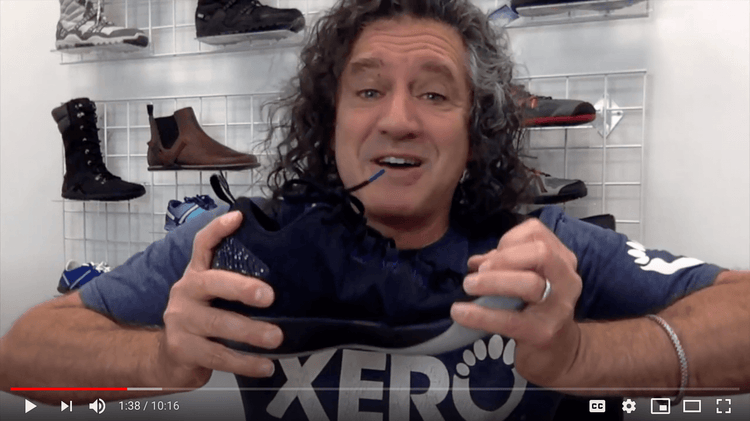
How to find TRULY comfortable shoes
The secret to finding comfortable shoes...It's probably not what you think.And it's definitely not what "Big Shoe" companies have been saying for the last 50 years.It's not because you need more arch support or better cushioning or to control your pronation or supination.The secret is actually what humans have been doing for ages.The secret to TRUE comfort is letting your feet do what's NATURAL.Think about this -- did you know 1/4 of the bones and joints of your ENTIRE body are in your feet and ankles?Did you know you have more nerve endings in your soles than anywhere but your fingertips or lips?CLEARLY, you're supposed to USE those things at the end of your legs.Your feet are made to bend and flex and move and FEEL the world (you'll want to do that safely, and I'll show you how).And it gets worse >> When your feet can't do their job, that function of helping you move and balance tries - UNSUCCESSFULLY -- to move "upstream" into your ankle, your knee, your hip, and your back.You want to let your feet do their job, so the rest of your body can do its job.But most shoes do the opposite of what's natural -- they squeeze your toes together, they elevate your heel (which messes with your posture), they insulate you from the ground so your brain can't tell what's going on with your feet (which means it doesn't have the info it needs to help you move your body efficiently and enjoyably).And NO amount of cushioning protects you from the impact of walking or running, or even just standing.ANOTHER QUESTION -- Remember being a kid on a warm summer day and going outside, kicking off your shoes, and feeling the grass between your toes, or the sand under your feet, or the water around your ankles?Remember how much fun it was to PLAY... until it got so dark your parents had to drag you home, even though you couldn't see your hand in front of your face or the ball you were trying to kick or hit?You can have that feeling of fun and freedom NOW... at any age.It comes from letting your feet do what's natural.Now, I'm NOT suggesting you run around barefoot like some aging hippy (I know that's what I look like, but my wife said she'd leave me if I cut my hair!)Once my wife and I discovered the fun and the benefits of natural movement, we started Xero Shoes to make footwear that LETS YOUR FEET BE FEET: - Natural Fit -- wide toe boxes let your toes spread and relax. A non-elevated (zero-drop) heel for proper posture. - Natural Motion -- super flexible to let your feet bend and move naturally. Low-to-the-ground for balance and agility. - Natural Feel -- the patented FeelTrue® soles give you just-right protection while still giving the ground feedback your brain needs for efficient, natural movement. All our casual and performance shoes, boots and sandals are super lightweight. They're made for almost any activity you do -- walk, run, hike, workout, do yoga or CrossFit, or even just stand on your feet all day for work.They're so comfortable that at the end of the day you may forget to take them off!We've had people email us to say, "I got into bed and then realized I was still wearing my Xero Shoes!"Plus they're affordable and so durable that they have a 5,000 mile sole warranty.Oh, and yes, we WERE on Shark Tank ;-)We've helped hundreds of thousands of people discover the fun, comfort, and benefits of natural movement and we hope you decide to do the same.Go to https://xeroshoes.com/shop/ to see which styles have your name on them. Check out the reviews (over 17,353 5-star reviews!), and get ready to Live Life Feet First!(And if you have any questions, our Customer Happiness Team is available to help -- 303.447.3100 or support@xeroshoes.com)
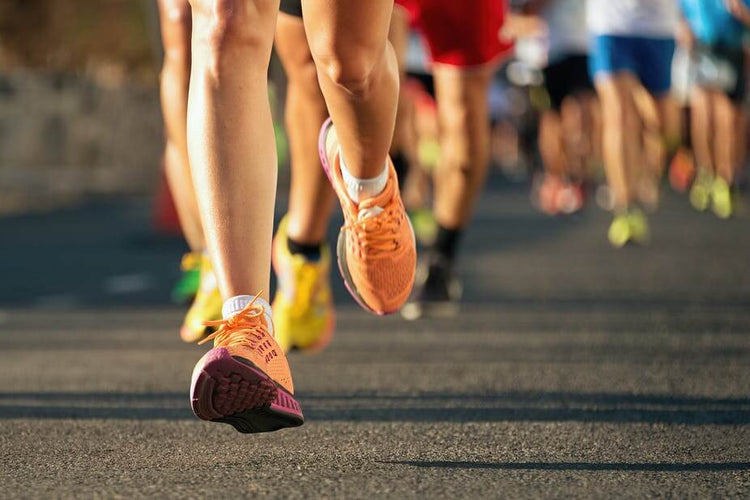
Do Running Shoes CAUSE Injuries?
When I talk to many runners who still use "traditional" running shoes,and then tell them about Xero Shoes, they often say "Well, there's a debate about barefoot/minimalist shoes."First, the quotes are because what we call "traditional" running shoes have only been around for less than 0.05% of the time humans have been wearing protective footwear.Second, there's really no debate.There are people who have opinions that barefoot/minimal is somehow bad based on limited amounts of research, or anecdotes, or information put out by companies that make traditional shoes, and then there is...THE TRUTHYes, I'm implying that the truth is: Natural Movement -- whether you're barefoot or in a truly minimalist shoe like Xero Shoes -- is demonstrably better than being in a padded, motion-controlled, heel-elevated, toe-squeezing shoe.But rather than hash out all my reasons for saying this (which I've done many times on this site), here's a great article that examines "shoes vs. barefoot":https://theconversation.com/running-shoes-may-cause-injuries-but-is-going-barefoot-the-fix-135264Here's the highlight:...if you want to give barefoot running a try, the best advice is to walk before you run. A minimalist shoe might be a good first step if walking or running in extreme temperatures or where sharp objects may be common. Although minimalist shoes aren’t the same as being barefoot, the mechanics runners and walkers use in them are very similar to when barefoot – and dramatically different to when in shoes.And this is the key point. It's about the MOVEMENT, not about the footwear. It just so happens that natural movement is fundamentally impossible in a shoe that, well, doesn't let your foot move. And a truly minimalist shoe can let your body do what's natural, and let your feet bend, flex, move, and FEEL.BTW, a "truly minimalist" shoe isn't the same as a shoe that's marketed as "minimalist" but that doesn't let your toes splay, your foot fend and flex, and your sole get feedback from the ground (which it sends to your brain to help your movement, balance, and agility).
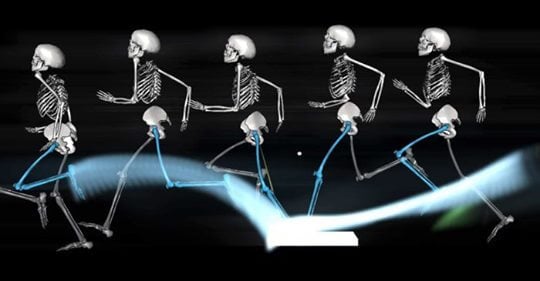
Are you running WRONG?
What's the difference between "good running" and "bad running"?Those of us who promote natural movement and barefoot running have some thoughts about that.Typically, we talk about: Landing with your foot "under your body" (don't reach out in front of your body with your foot -- "overstriding") Increase your cadence a bit (there's no magic number, like 180 steps per minute, but increasing your foot speed without increasing your running speed makes overstriding more difficult) Land on your forefoot or midfoot (it's hard NOT to land that way if you don't overstride, and don't point your toes to make this happen. BTW, some research suggests forefoot is better because it lets you use the "spring" in your foot's arch) Keep your core engaged (you want to be a "tight spring") But what does SCIENCE say?Well, take a look at this super-cool presentation by David Mark, showing some running analysis by biomechanist Dr. Aaron Beachhttps://www.abc.net.au/news/2019-12-11/why-everything-you-thought-about-running-is-wrong/11775598They use some great visualizations to compare Olympian Jenny Blundell to recreational runner, Ruby Cornish.The only thing different in Beach's analysis and recommendations from what I show above, is that he doesn't suggest trying forefoot landings. But my bet is that if Jenny was a forefoot landing runner he'd comment on the value of doing so.One other subtle thing is that he recommends that Ruby have more hip extension (or what some would call "backside mechanics"). This isn't something to work on, but simply the effect of having a stride where your foot lands under -- or close to -- your center of mass, with the correct cadence.It why we say that good runners "run out of the back."I think you'll love the visualizations. Let me know what you think.


